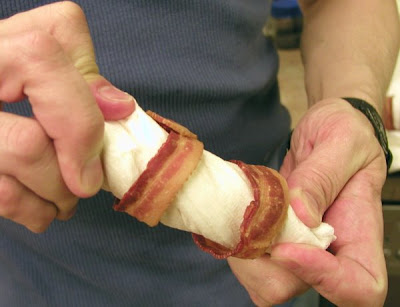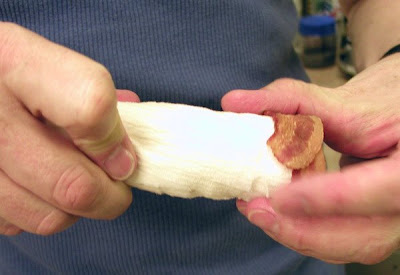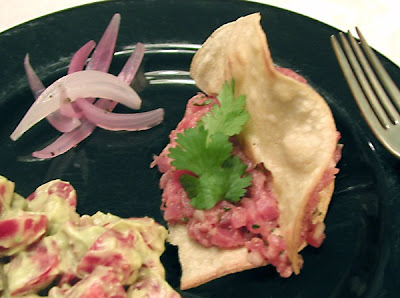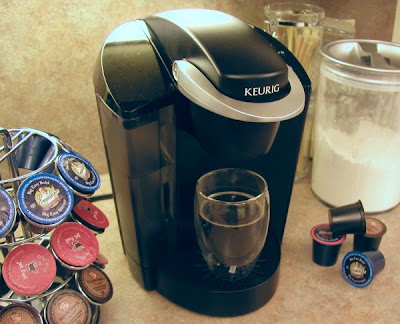
Back in 1997, Richard Rhodes published the brilliant Deadly Feasts, a study of the evolution of bovine spongiform encephalopathy, BSE, also called mad cow disease. Princess V read it and convinced me to do so as well. A well-written book about a fascinating topic, Deadly Feasts is also something of a deal-killer when it comes to beef consumption. Basically, the BSE threat comes down to three problems.
First, you can't see it coming. If the beef you're eating is infected, you can't see it, smell it, or taste it.
Second, the first symptoms are a death sentence. Once the prions begin to affect your brain, you're well on your way to brain damage and death.
Third, the USDA has been overwhelmingly slow and mind-numbingly stupid in its responses to BSE dangers. Preventing the spread entails essentially just two restrictions, but those restrictions have to be enforced absolutely: (1) no meat (especially not beef) can be fed to cattle and (2) downer cows—cows showing symptoms of BSE—have to be destroyed and not not not fed to anyone or anything.
So we don't eat a whole lot of beef in our house. Some, yes. Girltzik is fond of barbecued brisket and likes my oyster beef. Princess V likes pasta and meatballs. I like an occasional prime rib or some fajitas or maybe a bit of stroganoff. A few months back, I had an outstanding osso buco at a local Italian restaurant (Siena).
Okay, it's not exactly an out-and-out boycott, but compared to the way we ate when I was a kid, I may as well be a vegan. Growing up, I ate at least a couple of burgers every week. Pot roast showed up every week or two. Meatloaf, beef stew, and meatballs also made regular appearances.
Most important of all, my father believed in steak at least once a week—preferably grilled or broiled. Steak had a limited range of meaning for Dad: porterhouse, t-bone, rib-eye, rib steak, and tenderloin all qualified. Top sirloin was something you put in stews. Chuck, blade, seven-bone, and round never got more than a sneer. I think Dad considered steak—good steak—a measure of his overall financial health. Dad spent a portion of his childhood in poverty, so it was not uncommon for him to refuse various foodstuffs (rice-and-beans, collard or turnip greens, stew meat, grits, organ meats of all kinds) because they were "poor folk food." Steak was Dad's anti-poverty food—his middle-class status indicator. If we were eating steak, we clearly were not poor.
Princess V says the steak-as-status-symbol attitude is generational, that her father felt the same way. "Eating steak meant we were upper-middle-class."
These days, I rarely think about steaks, and I can't remember the last time I had a real rib-eye craving. What I've found in the past several years of limited beef consumption is that steak—no matter how beautifully marbled, no matter how well prepared—makes me logy. If I limit my intake to four or five ounces, I can avoid this problem. Sure. Stop after five ounces of juicy, prime cut rib-eye. Just say no to crack.
This week was almost one of those rare exceptions. I had been thinking about sauces. Last week I tried a vermouth Hollandaise on chicken breast. It was okay but a little lacking in sparkle. Next time, I'll try reducing the vermouth and adding some fresh thyme or sorrel. Along this same thought train, I came up with another variation I wanted to try: Côtes du Rhône black pepper Hollandaise. Côtes du Rhône is a fruity blended red wine that works beautifully in pan sauces because it concentrates without becoming overly sweet (like Merlot), bitter (Zinfandel), or tart (Cabernet Sauvignon, Burgundy, and many more).
I realized immediately that I wanted to pair this sauce with buffalo. If you enjoy flavorful beef, you should try American buffalo. It tastes quite a bit like concentrated beef without the least hint of gaminess. Be aware, however, that preparing buffalo differs in many respects from preparing beef. With the internationalization of Kobe beef and Wagyu beef, it's old news that the most flavorful cuts of beef are those with the highest fat content. In beef, marbling equals flavor. Buffalo, on the other hand, is ultra lean and yet manages to taste more intensely flavorful than beef. I don't know for certain, but I would guess the buffalo meat is higher in glutamines.
The lack of marbling may have no negative effect on the flavor of buffalo, but it does make the meat tough and chewy. This is enough of a problem that many cooks just surrender and grind the meat to hamburger which allows them to add beef fat.
Another solution—my solution of choice—is to slice the meat very thin and across the grain. If you slice it thin enough, the chewiness actually becomes something of a virtue in that it allows you to savor the meat without making it a chore to eat.
When I told Princess V what we were having for dinner, her eyebrows formed a couple of question marks. It was one of those looks that seemed to be asking, hmmm, how much do I have to eat to be polite?. She later admitted that she didn't expect to like the buffalo, but she kept an open mind and let it surprise her. Buffalo, because it doesn't rely on fat for its flavor, is savory without making you feel heavy.
The Girltzik also enjoyed the buffalo, but I think she was better pre-disposed toward it. She'd walked through the kitchen while I was slicing the meat. When she saw what I was preparing, she said, "Oh, we're having beef?"
"Nope. Buffalo."
"Buffalo! That is so intense."
I think she was looking forward to bragging to her friends about the way cool adventurous dinner she had.
I accompanied the buffalo with two sides: fried red potatoes tossed with bacon and white cheddar and a sauté of cremini mushrooms with green garlic.
Seared buffalo strip loin with Côtes du Rhône black pepper Hollandaise
(serves three)
dramatis personae
one tablespoon peanut oil
one pound buffalo strip loin
salt
black pepper
sauce
one cup Côtes du Rhône
one half teaspoon cracked black pepper
two egg yolks
one quarter cup melted butter
quality of ingredients
Buffalo steaks won't be marbled, so look for dark red, almost purple meat with no hint of brown and no dry spots.
The typical Côtes du Rhône costs between $10 and $15 per 750 ml, but that covers a lot of blends of varying qualities. If you don't happen to have a favorite Côtes du Rhône, go to a market with a knowledgeable staff and ask for advice.
Black pepper should be fresh-cracked for freshness. It loses pungency rapidly after cracking.
preparation notes
Preheat the oven to 275F.
My thanks to the folks at America's Test Kitchen and Cooks Illustrated for working out the basics of this process for searing steaks. The goal of this technique is a crispy brown exterior, a warm red heart, and no overcooked band of grey meat in between. If you don't pre-dry the steaks in the oven, the moisture near the surface acts like a heat sink, slowing the searing process.
Trim off the fat and cut the strip steak into two or three cubes (three if the strip's length is closer to three times its width; two if the ratio is closer to two to one). Liberally season the cubes with salt and pepper. On a wire rack over a broiler pan or cookie sheet, bake the meat at 275F for twenty minutes or until it reaches 90F in the center. This will dry out the surface of the steaks and parcook the center, which allows you to sear the steaks quickly.
In a cast-iron skillet, heat a tablespoon of peanut oil to smoking. Sear the steaks on one side for one minute. Flip the steaks and sear them on the other side for one minute. With a pair of tongs, rotate the steaks to sear them on the four remaining faces (twenty or thirty seconds each side).
Tent the steaks with foil and let them rest for ten minutes. This will allow the juices to redistribute so that less is lost when you slice them.
In a sauce pan, reduce one cup of Côtes du Rhône to two tablespoons of liquid.
Follow my directions for basic Hollandaise sauce, with the following substitutions:
two egg yolks instead of four
one quarter cup butter instead of one half cup
reduced Côtes du Rhône in lieu of lemon juice
black pepper in lieu of white
Slice the steaks very thin (about three-sixteenths of an inch thick), and drizzle them with the Hollandaise.





